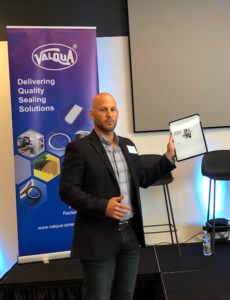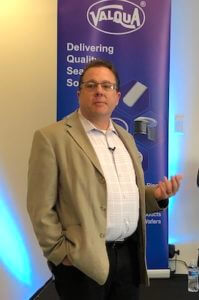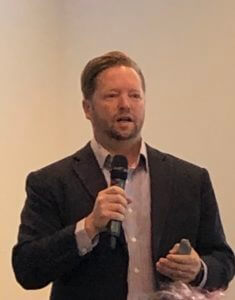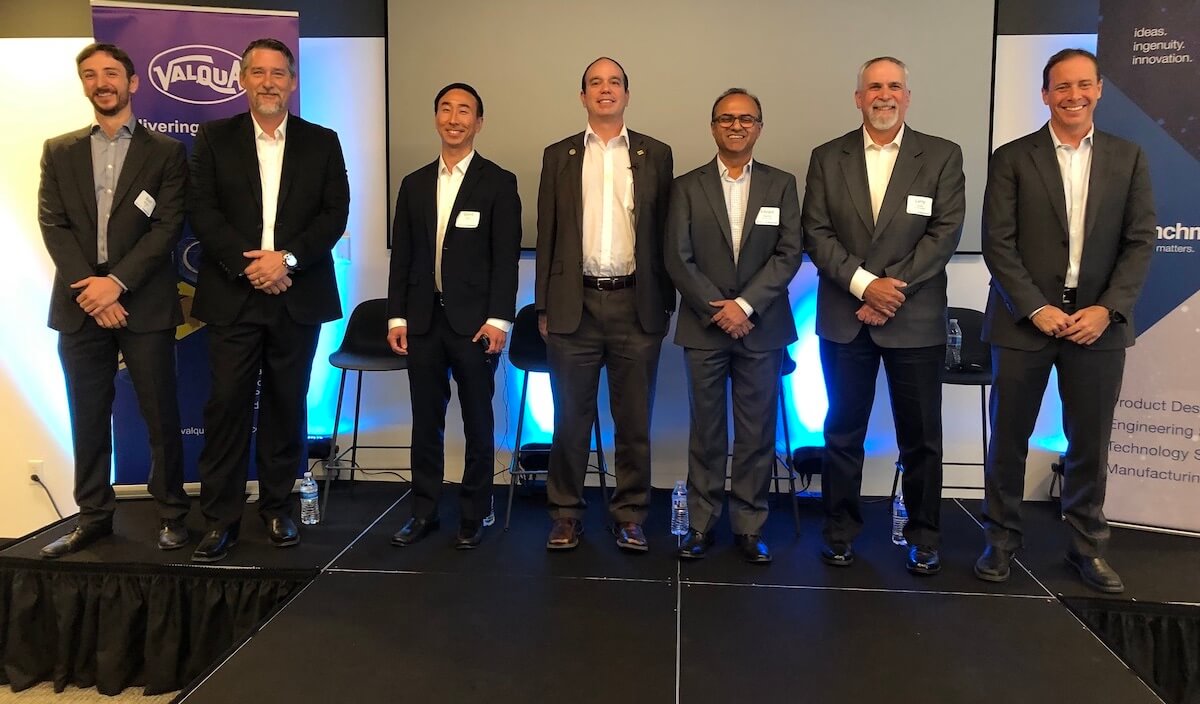It’s official. The world is becoming more data-driven by the second and everything – I mean EVERYTHING – hinges on the success of 5G. 5G will make smart factories more efficient; bring medical care to remote places; make the autonomous vehicle infrastructure possible so you stop rear-ending the person in front of you; allow you to download all six seasons of Downton Abbey while you are waiting for your urban air taxi to the office, and eventually, will allow you to ask Alexa to get you a cold beer from your fridge and deliver it to you while you enjoy more quality time with your six-year-old.
Ok, well maybe that last one was a stretch, but listening to the speakers at the recent SEMI Arizona Breakfast Forum expound on the virtues of a connected world enabled by 5G made me think that in the future, everything will be possible. Perhaps Scott Hicar, CIO of Benchmark Electronics, the company hosting the event, said it best:
“It’s about the data, throughput, and latency. We need to make sure the machine overlords are happy,” He said. “We’re talking about 30 billion connected devices in the not-to-distant future.”

More than 60 of those you can find in Jason Scilliari’s home. Scilliari spoke on behalf of Verizon, about the wireless provider’s progress in deploying its 5G infrastructure throughout the US. He has smartened up his home so much, he can now operate every appliance and light fixture from the comfort of his smartphone. Now that is living.
All Kidding Aside….
The SEMI Arizona Chapter did a stellar job lining up speakers and assembling a lively panel of experts from across the 5G ecosystem. Intel’s Zsolt Marcet, Ph.D. was the morning’s emcee. In addition to Hicar and Scilliari, speakers included Daniel Everitt, Benchmark; Scott Jones, KPMG; Paul Hart, NXP; Larry Surace, Honeywell; Brian Coppa, EMD Performance Materials; Grant Shoji, KLA; and Vik Chaudhry, Amkor Technology.

Hicar kicked things off, talking about the “waves of data” that have altered the course of how we live and do business since the 1980s. The first wave happened in the late ’80s and ’90s, driven by enterprise resource planning (ERP) data processing engines that kept track of internal information about your business: what you bought, who you sold it to, and what insight you gained. “It helped scale companies to the next level to create growth and value,” he said.
The second wave was the age of the Internet, which provided information about your customers, and how your products were perceived. We are on the brink of the third wave of data, which is 5G enabled, said Hicar. It allows you to capture data about your product at the moment it interacts with the customer. This is turning our smartphones into “data capture devices for what you do” thereby creating value for the corporations using it.
“Corporations will invest because they want to understand the experience of interacting with the product. The user experience will change, because of 5G speeds, low latency, voice recognition, AI at the edge, and augmented reality,” said Hicar. “This will change how technology products will deliver value to the marketplace.”
(Personally, I find the thought of this frightening. I don’t like the idea of my every move being tracked and that information sold to companies so they can create more products that I presumably need. But, heck, if that’s what you’re into…
The Maker Perspective

If it’s so great, how come 5G isn’t being deployed faster? Everitt offered the perspective of the maker. 5G is challenging because it requires a vastly different infrastructure to be built and deployed. Everitt enumerated the barriers we need to overcome:
- Lack of industry expertise designing and manufacturing frequencies
- Insufficient fiber backhaul infrastructure
- Lack of cooperation between the carriers, municipalities, and infrastructure owners for denser small-cell placement
Bottom line: we are looking at new kind of technology ecosystem; one that requires collaboration and partnerships. Carriers, hardware providers, city regulators, etc. need to learn how to coexist and work together to build a digital-enabled world.
5G Impacts Opportunity

Scott Jones provided insight on 5G investment drivers, optimizing the network, costing, and changing business models brought about by 5G, and a global look at deployment.
Data traffic is expected to increase, requiring significant investment in the infrastructure to meet the demand. 5G densification is expected to drive macro and small cell deployment, reaching CAGRs of 2% and 24% respectively from 2018-2028, he noted. Building the network requires a heterogenous approach involving pico and microcells connecting IoT devices, vs traditional towers.
Jones said the role of the carrier is transforming. 5G will bring about lots of different business models. Service-based models built around the internet of things (IoT) and mobile devices that deliver in real-time will be at the forefront. The device user is at the center, connected to the entire ecosystem.
He also described a novel approach network optimization that involves “slicing” network functions according to different types of 5G traffic. This will enable high traffic usage at a lower cost. The cost of this is more expensive to deploy upfront, and carriers are struggling to figure out return-on-investment models because it depends on business models that don’t exist yet, said Jones.
“As excited as we are about 5G, we are a few years (three or more) away from seeing the business impact,” said Jones. “Meaningful adoption and carrier growth are a few years out.” He added that South Korea and the US are leading the way with available 5G offerings in key pilot markets. Investments in the US are high, putting them in the leading edge. In South Korea, the density of the population makes it easier to deploy.
Harnessing the Full RF Bandwidth for 5G
Calling NXP Semiconductors the “largest RF company nobody’s ever heard of, Paul Hart provided a reality check on the RF components needed to make 5G happen. He said the heterogeneous network mentioned by Jones is a great concept, but it’s going to be difficult to implement because it requires merging all the RF components and antennas into a common box.
The diversity of antenna solutions is increasing, making it far more complicated and complex. “We have to tailor every solution, which is a massive headache and nightmare,” he explained. “There are challenges with network deployment, scheduling, and cost. Until the whole supply chain has moved, the cost doesn’t come down.”
The first mmWave radios came on the market in 2019, which brought about the first surge in 5G business and made an impact. South Korea did its full deployment using 3.5 GHz, with 32 transmitters per box.
Hart explained that it’s not as simple as replacing 4G with 5G but requires a blend of solutions. 4G systems are getting software upgrades. mM wave solutions are being deployed in dense areas. There is not a one-size-fits-all solution. It requires a range toolbox from sub-1GHz to mmWave.
Hart’s overarching message: successful deployment and adoption of 5G require partnership and collaboration. Costs will delay 5G networks around the world. His was not a user-focused talk. He provided a look at the challenges devices manufacturers are facing.
I asked what comes first, the network or the handsets? Hart said that the network is built out enough in the US that people are beginning to invest in 5G phones. The more that happens, the more investments will come in to build out the network faster.
Another clarification I want to make is that the 5G everyone is talking about now is really 5G lite – a combination of LTE and 5G technologies, so that the carriers and handset makers can claim to have started implementing the 5G infrastructure. Hart explained, for example, that while Chicago claims to have 5G deployed, the downloads are at 5G speeds, but the uploads are likely still using LTE.
Urban Air Mobility as a 5G Use Case
All the panelists, save Larry Surace from Honeywell, talked about the impact of 5G on their segments of the supply chain. He explained Honeywell’s role in Uber Elevate – a program for urban air mobility. He talked about 3-4 passenger electrified helicopters that will transport people from Point A to Point B along a pre-determined route using “sky lanes” and landing in “Vertiports”. These sky lanes will be “defined and mature” following roadways for noise abatement. In the initial phase, licensed pilots will fly the vehicles, but the ultimate goal is to have “simplified vehicle operators” as autonomous functions are added. The target rollout for this program is 2025.
Surace says this futuristic application requires advancements in beamforming technologies. The vehicles need 5G for dual purposes: to provide vehicle-to-vehicle communication and allow the passengers to use their devices to conduct business, or whatever. Urban air mobility won’t mature until the 5G infrastructure is established. Regarding questions about the FAA and safety, Surace assured us that Uber is working closely with the FAA to build Class B vehicles that are as safe as commercial planes.
Call me conventional, but I commute to downtown Phoenix every day, and the thought of the busy freeways with busy sky lanes overhead, does not appeal to me at all. And given Uber’s safety history, you won’t find me boarding one of these vehicles EVER. I’ll just stick to the streets.
5G Impacts on the Semiconductor Supply Chain
So what about the semiconductor suppliers? Coppa, Shoji, and Chaudhry all agreed that 5G spells opportunity for their companies.
Chaudry talked about the unique packaging challenges 5G poses for modems and processors. Managing signal integrity and the signal path is critical for mmWave technology. Amkor’s antenna in Package (AiP), system-in-package (SiP) and fan-out technology adoption will all benefit from the needs of 5G. “I see packages becoming part of the overall system design. Whole systems will be simulated with package parameters,” he said. “The OSAT market will benefit from the sheer volume of mobile devices, which will commoditize the technology and bring down the price.”
Will 5G will breathe new life into the declining handset market? Chaudry said it’s hard to say. While 5G phones will eclipse 4G phones by 2023, he doesn’t expect sales to surge because consumers around the world no longer rush to replace their phones. However, 5G means semiconductor sales will increase because the content in the phones will increase.
Representing the materials sector, Brian Coppa says that as 5G chips take off next year, there will be significant demand for materials across the supply chain. In particular, compound semiconductors will be introduced into the fab, where they haven’t been used much in the past. 5G calls for silicon carbide(SiC), gallium nitride, and other III-V materials that have higher electronic mobility than silicon. He said these new thin films need new etch gases and slurries. Additionally, as there is only one US supplier of SiC substrates, we can expect a supply crunch. This company (Cree) has anticipated the problem and is building a billion-dollar factory to make up for the shortage, noted Coppa.
KLA’s Grant Shoji talked about metrology being more expensive for mmWave technology. He also said that because silicon carbide devices are manufactured in six-inch fabs, existing process tools can be reconfigured for the process. However, challenges exist for inspection and metrology using 20-year old equipment. He said KLA is incorporating AI into the algorithms of its process and inspection tools to optimize decisions for better results and improved productivity.
The Panel’s Takeaways
It seems fitting to close this post covering the SEMI Arizona Breakfast Forum with takeaways observed by the panelists, as that was the final question posed by Daniel Everitt.
Surace said he’d like to see more engagement on beam steering capabilities. “I’m excited about the pace of rollout and adoption,” he said. “It will serve itself to enable other big markets.”
Chaudry said the infrastructure shows a lot of growth. “That will be a fundamental difference between the adoption of 4G and 5G.” he said.
Coppa said he thinks 5G will bring about a self-fulfilling prophecy. Chips will be developed and used to support the 5G infrastructure, and the semiconductor industry will enjoy the benefits of the 5G infrastructure itself as its factories become more automated. “As more chips come into the market, efficiencies in overall productivity will improve the cycle time of fabs.” He said. “Companies that build more efficient factories will have more money to spend on R&D.”
Based on the questions asked by the audience during the panel, Shoji said he learned that flying cars are more interesting than finding defects on wafers. “It’s exciting to be living in these times and see where it goes.”
And that’s a wrap, from Tempe, Arizona. ~ FvT





















